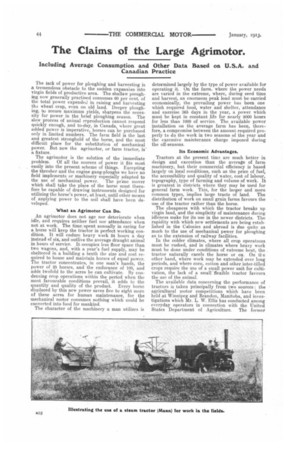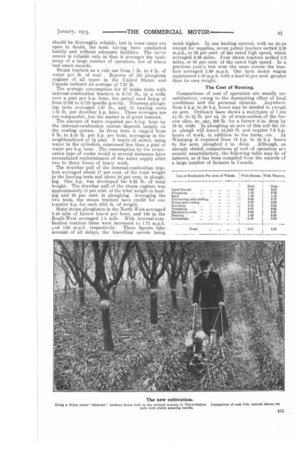The Claims of the Large Agrimotor.
Page 66

Page 67

If you've noticed an error in this article please click here to report it so we can fix it.
The lack of power for ploughing and harvesting is a. tremendous obstacle to the sudden expansion into virgin fields of productive area. The shallow pioughnig now generally practised consumes 60 per cent, of the total power expended in raising and harvesting tha wheat crop, even on old land. Deeper ploughing, el.) secure maximum yields, sharpens the necessity for power in the brief ploughing season. The slow process of animal reproduction cannot respond quickly enough, and to-day, in Canada, where great added power is imperative, horses can be purchased only in limited numbers. The farm field is the last and greatest stronghold of the horse, and the most difficult place for the substitution of mechanical power. But now the agrimotor, or farm tractor, is a fixture.
The agrimotor is the solution of the immediate problem. Of all the sources of power it fits most easily into the present scheme of things. Excepting the thresher and the engine gang-ploughs we have no field implements or machinery especially adapted to the use of mechanical power. The prirne mover which shall take the place of the horse must therefbre be capable of drawing instrunients designed for utilizing the horse's power, at least, until other means of applying power to the soil shall have been developed.
What an Agrimotor Can Do.
An agrimotor does not age nor deteriorate when idle, and requires neither fuel nor attendance when not at work. The time:spent annually in caring for a horse will keep the tractor in perfect working condition. ft will endure heavy work 24 hours a day instead of six, and outlive the average draught animal in hours of service. It occupies less floor space than two wagons, and, with a. year's fuel supply, may be sheltered in a building a tenth the size and cost required to house and maintain horses of equal power. The tractor concentrates, in one man's hands, the power of 25 horses, and the endurance of 100, and adds twofold to the acres he can cultivate. By condensing crop operations within the period when the most favourable conditions prevail, it adds to the quantity and quality of the product. Every horse displaced by this new power saves five to eight more of these acres for human maintenance, for the mechanical motor consumes nothing which could be converted into food for mankind.
The character of the machinery a man utilizes is determined largely by the type of power available for operating it. On the farm. where the power needs are varied in the extreme, where, during seed time and harvest, an enormous peak load must be 'carried economically, the prevailing power has been one which required food, water and shelter, attendance and exercise 365 days in the year, a power which must be kept in constant life for nearly 9000 hours for less than 1000 of service. The available power installation on the average farm has been, therefore, a compromise between the amount required properly to do the work in two seasons of the year and the excessive mainterance charge imposed during the off-seasons.
Its Economic Advantages.
Tractors at the present time are much better in design and execution than the average of farm machinery, but their commercial efficiency is based largely on local conditions, such as the price of fuel; the accessibility and quality of water, cost of labour, topography, type of farming and volume of work. It is greatest in districts where they may be used for general farm work. This, for the larger and more common types, implies large tracts of land. The distribution of work on small grain farms favours the use of the tractor rather than the horse.
The cheapness with which the tractor breaks up virgin land, and the simplicity of maintenance during idleness make for its use in the newer districts. The rapidity with which new settlements are being established in the Colonies and abroad is due quite as much to the use of mechanical power for ploughing as to the extension of railway facilities.
In the colder climates, where all crop operations must be rushed, and in climates where heavy work must be done under conditions of extreme heat, the tractor naturally excels the horse or ox. On the other hand, where work may be extended over long periods, and where corn, cotton and other inter-tilled crops require the use of a small power unit for cultivation, the lack of a small flexible tractor favours the use of the animal.
The available data concerning the performance of tractors is taken principally from two sources : the agricultural motor competitions which have been held at Winnipeg and Brandon, Manitoba, and investigations which Mr. L. W. Ellis has conducted among everyday operators in connection with the United States Department of Agriculture. The former should be thoroughly reliable, but in some cases are open to doubt, the tests having been conducted hastily and without adequate facilities. The latter source is reliable only in that it averages the testimony of a large number of operators, few of whom had exact records.
Steam tractors as a. rule use from 7 lb. to 8 lb. of water per lb. of coal. Reports of 333 ploughing engines of all types in the United States and Canada indicate an average of 7.67 lb.
The average consumption for 27 brake tests with internal-combustion tractors is 0.747 lb., or a trifle over a pint per h.p. hour, the petrol used being of from 0.700 to 0.710 specific gravity. Nineteen ploughing tests averaged 1.67 lb., and 12 hauling tests 1.81 lb. per drawbar h.p. hour. These averages are not comparable, but the matter is of great interest. The amount of water required per b.h.p. hour by the internal-combustion motors depends largely on the cooling system. In these tests it ranged from 0 lb. to 2.55 lb. per h.p. per hour, averaging in the neighbourhood of 1i pint. A heavy-oil motor, using water in the cylinders, consumed less than _a pint of water per h.p. hour. The consumption by the evaporative type of cooler would in several instances have necessitated replenishment of the water supply after two to three hours of heavy work.
The drawbar pull of the internal-combustion tractors averaged about 17 per cent, of the total weight in the hauling tests and about 24 per cent. in ploughing. One h.p. was developed for 9.22 lb. of total 'weight. The drawbar pull of the steam engines was approximately 11 per cent. of the total weight-in hauling and 22 per cent. in ploughing. Averaging the two tests, the steam tractors have credit for one tractive h.p. for each 1033 lb. of weight.
Sixty steam ploughmen in the North-West averaged 1.48 mile of furrow travel per hour, and 100 in the !South-West averaged 1.5 mile. With internal-combustion tractors these were increased to 1.73 m.p.h. r,nd 1.68 m.p.h. respectively. These figures take account of all delays, the travelling speeds being much higher. In one hauling contest, with no sti ps except for supplies, seven petrol tractors netted 2.39 m.p.h., or 92 per cent, of the rated high speed, which averaged..2.59 miles. Four steam tractors netted 2.2 miles, or 86 per cent. of the rated high speed. In a previous year's test over the same course the tractors averaged 2.99 m.p.h. One farm motor wagon maintained 4.42 m.p.h. with a load 50 per cent. greater than its own weight.
The Cost of gunning.
Comparisons of cost of operation are usually unsatisfactory, owing to the dominating effect of local conditions and the personal element. Anywhere from 5 h.p. to 20 h.p. hours may be needed to piough an acre. Ordinary loam shows a resiztance of f. can lb. to 5i lb. per sq. in. of cross-section of the furrow slice, or, say, 300 lb. for a furrow 6 in. deep by 12 in. wide. In ploughing an acre of this soil the 12in. plough will travel 43,580 ft. and require 7.9 h_p.
hours of work, in addition to the turns, .ete. At Winnipeg it required from 12 11.p. to 19 h.p hours to the acre, ploughed 4 in. deep. Although, as already stated, comparisons of cost of operation aro usually unsatisfactory, the following table may be of interest, as it has been compiled from the records a a large number of farmers in Canada.


























































































